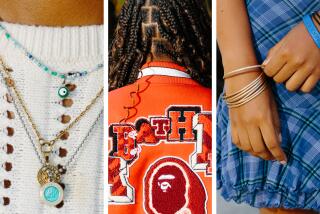Picking Clothes Suited for Work
- Share via
A guy walks into a job interview wearing a knit cap--rapper style--in the middle of the summer. Do you hire him?
Kristi Cameron, human resources generalist at Best Software Inc., did. But she did not hire the man who interviewed in a dress shirt with no undershirt. The difference? The latter’s bottom button was bulging, exposing his less-than-cute stomach. The former, says Cameron, “was well-groomed.”
You may be incredulous that the cap-wearing interviewee got the job. After all, he broke the rule that your mother pounded into you your whole life: Take that hat off.
But when it comes to workplace style, it’s all about balance. Says Mary Lou Andre, a Boston-area fashion consultant, there are three things to remember when it comes to dressing for your career: appropriateness, boundaries and respect.
There are some things that are never in line, Andre says. Especially for young people, it’s important to look extra serious. “Don’t look like you’d rather be at the beach, because [the older people in the office] are going to tend to think that anyway.”
But usually what separates the do’s from the don’ts varies widely across industries. We asked several managers and fashion experts to give us some guidelines.
“I’m embarrassed to say [clothing] has been the topic of more of my discussions than I care to admit,” says Tim Davenport, president and chief executive of Best Software of Reston, Va.
For example, Davenport says, most of the programmers at Best Software dress casually--even in jeans. But in the past, the executives would hold powwows before customer visits to decide what to wear in order not to offend the client. But when the executives would then take the group on a company tour, everyone would be in the typical casual garb.
Eventually, Davenport started informing customers pre-visit that the company has a casual dress code. That way, he and his colleagues didn’t need to put on a show, and everyone knew what to expect. The situation illustrates an important point: Techies may dress down, but they are more sensitive to clothing etiquette than you might think.
Davenport, who worked at Lotus in the early days when jeans and running shoes first became the standard techie uniform, doesn’t mind this look. But he draws the line at shorts and sandals.
As a young software engineer or computer programmer, you might want to save your experimentation for weekends. This especially applies when you have to dress up. If you have a work engagement that calls for a suit, stick to a dark suit, white shirt and red tie, Davenport says. People who are inexperienced with formal wear, he says, “should stick to the tried and true.”
Striking the Right Balance
In the medical profession, the trick is walking the line between well-dressed and overdone. The patients “are sick; they don’t want to see glamour,” says Stephanie Harvey, a registered nurse and director of education at Prince George’s Hospital Center in Maryland.
But patients--and fellow health care workers--do expect a doctor or nurse to be the image of clean style. At Prince George’s, Harvey says, male and female doctors usually wear suits to make their rounds. Open-toed shoes on nurses and doctors are prohibited for safety reasons, Harvey says (wheelchairs and gurneys can be hazardous to toes). But this safety measure has become a fashion standard; even if you’re not a doctor or nurse, showing your toes will get you at least a few disapproving stares, if not worse.
If you’ve recently graduated from resident status, you’re probably used to wearing more casual--and inexpensive--clothing. Now that you’re expected to dress up, don’t think you have to spend what the well-established physicians do to look richly dressed. Andre, who edits the national newsletter Dressing Well, has advice for those on a tight budget. She suggests putting your money into a good blazer or suit and skimping on other things such as shirts and blouses. Especially for women, she says, “the major garment is the jacket. . . . It pulls everything together.”
If you’re still trying to cut costs, here’s more advice from Andre: “A cheap black blazer looks better than a cheap white blazer.” Dark colors hide deficiencies such as low-quality material. So if you have to skimp, go as dark as you can.
One last word of advice from Pamela Zacha, a former New York City fashion stylist who now owns Nimbus Communications Inc. and consults in the medical and financial fields: “Invest in a good dry cleaner. I have been in so many meetings where you could tell things hadn’t been pressed right, or at all.”
More to Read
Inside the business of entertainment
The Wide Shot brings you news, analysis and insights on everything from streaming wars to production — and what it all means for the future.
You may occasionally receive promotional content from the Los Angeles Times.










